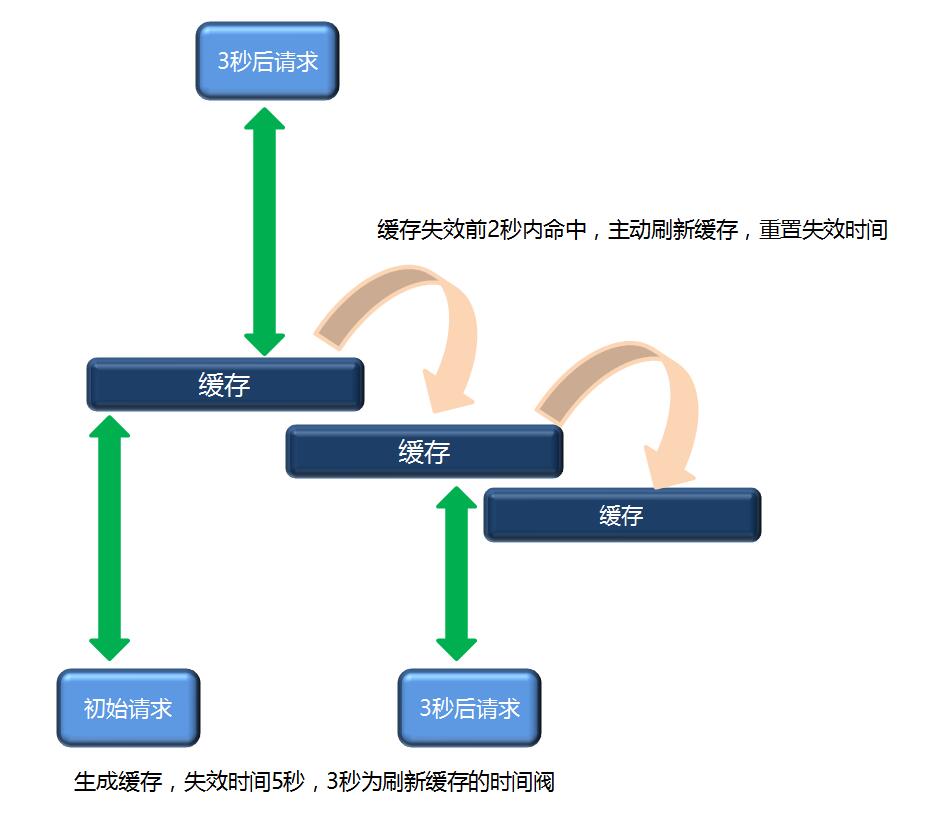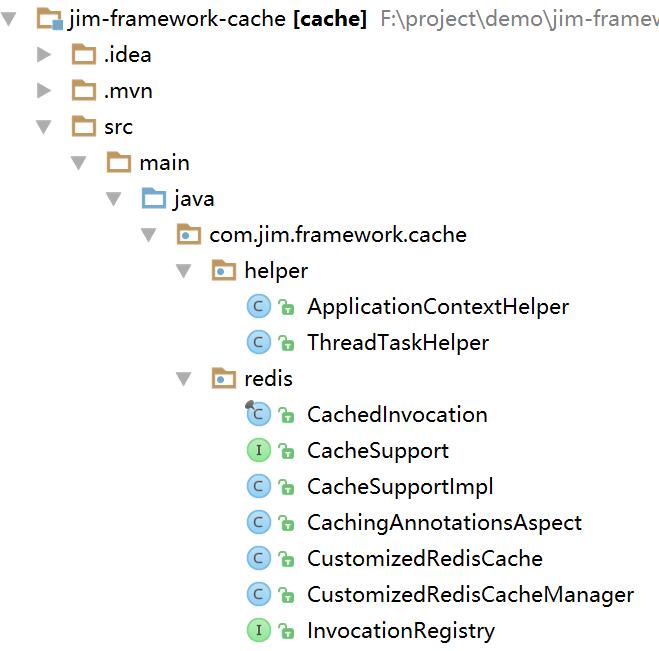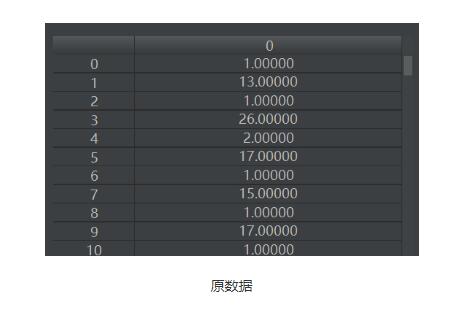Spring Cache擴展功能實現過程解析
兩個需求緩存失效時間支持在方法的注解上指定
Spring Cache默認是不支持在@Cacheable上添加過期時間的,可以在配置緩存容器時統一指定:
@Beanpublic CacheManager cacheManager( @SuppressWarnings('rawtypes') RedisTemplate redisTemplate) { CustomizedRedisCacheManager cacheManager= new CustomizedRedisCacheManager(redisTemplate); cacheManager.setDefaultExpiration(60); Map<String,Long> expiresMap=new HashMap<>(); expiresMap.put('Product',5L); cacheManager.setExpires(expiresMap); return cacheManager;}
想這樣配置過期時間,焦點在value的格式上Product#5#2,詳情下面會詳細說明。
@Cacheable(value = {'Product#5#2'},key ='#id')
上面兩種各有利弊,并不是說哪一種一定要比另外一種強,根據自己項目的實際情況選擇。
在緩存即將過期時主動刷新緩存
一般緩存失效后,會有一些請求會打到后端的數據庫上,這段時間的訪問性能肯定是比有緩存的情況要差很多。所以期望在緩存即將過期的某一時間點后臺主動去更新緩存以確保前端請求的緩存命中率,示意圖如下:

Srping 4.3提供了一個sync參數。是當緩存失效后,為了避免多個請求打到數據庫,系統做了一個并發控制優化,同時只有一個線程會去數據庫取數據其它線程會被阻塞。
背景
我以Spring Cache +Redis為前提來實現上面兩個需求,其它類型的緩存原理應該是相同的。
本文內容未在生產環境驗證過,也許有不妥的地方,請多多指出。
擴展RedisCacheManagerCustomizedRedisCacheManager
繼承自RedisCacheManager,定義兩個輔助性的屬性:
/** * 緩存參數的分隔符 * 數組元素0=緩存的名稱 * 數組元素1=緩存過期時間TTL * 數組元素2=緩存在多少秒開始主動失效來強制刷新 */ private String separator = '#'; /** * 緩存主動在失效前強制刷新緩存的時間 * 單位:秒 */ private long preloadSecondTime=0;
注解配置失效時間簡單的方法就是在容器名稱上動動手腳,通過解析特定格式的名稱來變向實現失效時間的獲取。比如第一個#后面的5可以定義為失效時間,第二個#后面的2是刷新緩存的時間,只需要重寫getCache:
解析配置的value值,分別計算出真正的緩存名稱,失效時間以及緩存刷新的時間 調用構造函數返回緩存對象@Overridepublic Cache getCache(String name) { String[] cacheParams=name.split(this.getSeparator()); String cacheName = cacheParams[0]; if(StringUtils.isBlank(cacheName)){ return null; } Long expirationSecondTime = this.computeExpiration(cacheName); if(cacheParams.length>1) { expirationSecondTime=Long.parseLong(cacheParams[1]); this.setDefaultExpiration(expirationSecondTime); } if(cacheParams.length>2) { this.setPreloadSecondTime(Long.parseLong(cacheParams[2])); } Cache cache = super.getCache(cacheName); if(null==cache){ return cache; } logger.info('expirationSecondTime:'+expirationSecondTime); CustomizedRedisCache redisCache= new CustomizedRedisCache( cacheName, (this.isUsePrefix() ? this.getCachePrefix().prefix(cacheName) : null), this.getRedisOperations(), expirationSecondTime, preloadSecondTime); return redisCache;}
CustomizedRedisCache
主要是實現緩存即將過期時能夠主動觸發緩存更新,核心是下面這個get方法。在獲取到緩存后再次取緩存剩余的時間,如果時間小余我們配置的刷新時間就手動刷新緩存。為了不影響get的性能,啟用后臺線程去完成緩存的刷新。
public ValueWrapper get(Object key) { ValueWrapper valueWrapper= super.get(key); if(null!=valueWrapper){ Long ttl= this.redisOperations.getExpire(key); if(null!=ttl&& ttl<=this.preloadSecondTime){ logger.info('key:{} ttl:{} preloadSecondTime:{}',key,ttl,preloadSecondTime); ThreadTaskHelper.run(new Runnable() {@Overridepublic void run() { //重新加載數據 logger.info('refresh key:{}',key);CustomizedRedisCache.this.getCacheSupport().refreshCacheByKey(CustomizedRedisCache.super.getName(),key.toString());} }); } } return valueWrapper;}
ThreadTaskHelper是個幫助類,但需要考慮重復請求問題,及相同的數據在并發過程中只允許刷新一次,這塊還沒有完善就不貼代碼了。
攔截@Cacheable,并記錄執行方法信息
上面提到的緩存獲取時,會根據配置的刷新時間來判斷是否需要刷新數據,當符合條件時會觸發數據刷新。但它需要知道執行什么方法以及更新哪些數據,所以就有了下面這些類。
CacheSupport
刷新緩存接口,可刷新整個容器的緩存也可以只刷新指定鍵的緩存。
public interface CacheSupport {/** * 刷新容器中所有值 * @param cacheName */void refreshCache(String cacheName);/** * 按容器以及指定鍵更新緩存 * @param cacheName * @param cacheKey */void refreshCacheByKey(String cacheName,String cacheKey);}
InvocationRegistry
執行方法注冊接口,能夠在適當的地方主動調用方法執行來完成緩存的更新。
public interface InvocationRegistry {void registerInvocation(Object invokedBean, Method invokedMethod, Object[] invocationArguments, Set<String> cacheNames);}
CachedInvocation
執行方法信息類,這個比較簡單,就是滿足方法執行的所有信息即可。
public final class CachedInvocation { private Object key; private final Object targetBean; private final Method targetMethod; private Object[] arguments; public CachedInvocation(Object key, Object targetBean, Method targetMethod, Object[] arguments) { this.key = key; this.targetBean = targetBean; this.targetMethod = targetMethod; if (arguments != null && arguments.length != 0) { this.arguments = Arrays.copyOf(arguments, arguments.length); } }}
CacheSupportImpl
這個類主要實現上面定義的緩存刷新接口以及執行方法注冊接口
刷新緩存
獲取cacheManager用來操作緩存:
@Autowiredprivate CacheManager cacheManager;
實現緩存刷新接口方法:
@Overridepublic void refreshCache(String cacheName) {this.refreshCacheByKey(cacheName,null);}@Overridepublic void refreshCacheByKey(String cacheName, String cacheKey) {if (cacheToInvocationsMap.get(cacheName) != null) {for (final CachedInvocation invocation : cacheToInvocationsMap.get(cacheName)) {if(!StringUtils.isBlank(cacheKey)&&invocation.getKey().toString().equals(cacheKey)) {refreshCache(invocation, cacheName);}}}}
反射來調用方法:
private Object invoke(CachedInvocation invocation)throws ClassNotFoundException, NoSuchMethodException, InvocationTargetException, IllegalAccessException {final MethodInvoker invoker = new MethodInvoker();invoker.setTargetObject(invocation.getTargetBean());invoker.setArguments(invocation.getArguments());invoker.setTargetMethod(invocation.getTargetMethod().getName());invoker.prepare();return invoker.invoke();}
緩存刷新最后實際執行是這個方法,通過invoke函數獲取到最新的數據,然后通過cacheManager來完成緩存的更新操作。
private void refreshCache(CachedInvocation invocation, String cacheName) {boolean invocationSuccess;Object computed = null;try {computed = invoke(invocation);invocationSuccess = true;} catch (Exception ex) {invocationSuccess = false;}if (invocationSuccess) {if (cacheToInvocationsMap.get(cacheName) != null) {cacheManager.getCache(cacheName).put(invocation.getKey(), computed);}}}
執行方法信息注冊
定義一個Map用來存儲執行方法的信息:
private Map<String, Set<CachedInvocation>> cacheToInvocationsMap;
實現執行方法信息接口,構造執行方法對象然后存儲到Map中。
@Overridepublic void registerInvocation(Object targetBean, Method targetMethod, Object[] arguments, Set<String> annotatedCacheNames) {StringBuilder sb = new StringBuilder();for (Object obj : arguments) {sb.append(obj.toString());}Object key = sb.toString();final CachedInvocation invocation = new CachedInvocation(key, targetBean, targetMethod, arguments);for (final String cacheName : annotatedCacheNames) {String[] cacheParams=cacheName.split('#');String realCacheName = cacheParams[0];if(!cacheToInvocationsMap.containsKey(realCacheName)) {this.initialize();}cacheToInvocationsMap.get(realCacheName).add(invocation);}}
CachingAnnotationsAspect
攔截@Cacheable方法信息并完成注冊,將使用了緩存的方法的執行信息存儲到Map中,key是緩存容器的名稱,value是不同參數的方法執行實例,核心方法就是registerInvocation。
@Around('pointcut()')public Object registerInvocation(ProceedingJoinPoint joinPoint) throws Throwable{Method method = this.getSpecificmethod(joinPoint);List<Cacheable> annotations=this.getMethodAnnotations(method,Cacheable.class);Set<String> cacheSet = new HashSet<String>();for (Cacheable cacheables : annotations) {cacheSet.addAll(Arrays.asList(cacheables.value()));}cacheRefreshSupport.registerInvocation(joinPoint.getTarget(), method, joinPoint.getArgs(), cacheSet);return joinPoint.proceed();}
客戶端調用
指定5秒后過期,并且在緩存存活3秒后如果請求命中,會在后臺啟動線程重新從數據庫中獲取數據來完成緩存的更新。理論上前端不會存在緩存不命中的情況,當然如果正好最后兩秒沒有請求那也會出現緩存失效的情況。
@Cacheable(value = {'Product#5#2'},key ='#id')public Product getById(Long id) { //...}
代碼
可以從項目中下載。

引用
刷新緩存的思路取自于這個開源項目。https://github.com/yantrashala/spring-cache-self-refresh
以上就是本文的全部內容,希望對大家的學習有所幫助,也希望大家多多支持好吧啦網。
相關文章:

 網公網安備
網公網安備